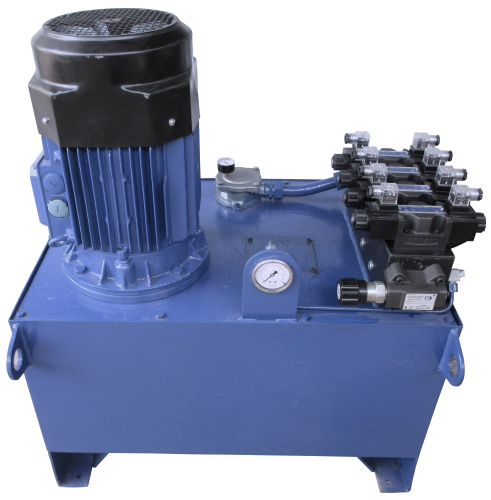It can be quite tricky to understand the purpose of hydraulic power packs/units for first-time users. Even experienced individuals may struggle to get them right. When it comes to hydraulic power packs, understanding what and how they work is critical to smooth operations. Deeper insight into the system also helps in maintenance and avoiding costly repairs. That is why we are here to help you out and take a closer look at the hydraulic power pack.
What is hydraulic power?
Hydraulic power is the power exerted by a fluid in a closed system. In technical terms, it is a conversion of power through pressurised hydraulic fluid flow. Hydraulic power enables machines to work better, faster, and stronger. It also helps the machines to run throughout a working day. The pressurised flow of fluid generates the power necessary to lift heavy weights, run tractors or trucks, and more.
What is a hydraulic power pack?
A hydraulic power pack is a standalone system that consists of a fluid reservoir, a motor, and a pump. They can operate independently and provide the power needed to move hydraulic fluid. By producing hydraulic pressure, it drives the motors, cylinders, or any other moving part of the hydraulic system.
These power packs are fitted inside many machines and come in all shapes and sizes. Some can span up to the size of a car while others can be the size of your everyday hurricane generator. It can, therefore, be tricky trying to pick up one of your requirements. Nevertheless, there are a variety of options to choose from and They all work in different ways to get the job done. Some hydraulic power pack units are immobile which means that they cannot be transported from one location to another. Others are smaller and more compressed, well-suited to movement and transportation. You can take them from one location to another to complete any kind of work depending on your preferences or requirements.
So, what do they look like?
The next question that automatically pops into your head is what hydraulic power units look like. To identify hydraulic power packs, it is a good idea to get to know the key factors. Hydraulic power packs come in many different shapes and sizes, some are very big and stationary while others are much smaller and portable. Some hydraulic power are so compressed that they can be easily transported in a small van. The easiest way to recognize hydraulic power packs is through their main mechanisms. All power packs usually have the following; a hydraulic reservoir, regulators, a pump, a motor, pressure supply lines, and relief lines.
What do these components do?
You may already have an idea about what these components do but a refresher does not hurt. Firstly, we have the hydraulic reservoir that holds the fluid and they come in different sizes. Next up are the regulators. Regulators are very important as they handle and control the amount of pressure that the hydraulic powerpack delivers.
Thirdly, we have pressure supply lines and relief lines. Supply lines help supply fluid under pressure to the pump, while relief lines dismiss pressure between the pump and the valves. Additionally, relief lines also control the direction of flow through the system.
Lastly, we have the pump and motor. The motor powers the pump. Now the pump generally has two roles. Firstly, it operates as a vacuum at the pump inlet and via atmospheric pressure forces fluid from the reservoir into the inlet line and then back to the pump. Secondly, it delivers the fluid back to the pump outlet and pumps it into the hydraulic system.
What is the purpose of hydraulic power packs?
Hydraulic power packs distribute power via a control valve which in turn runs the machine it is connected to. They come with a range of valve connections which means that you can power a range of machines using the right valves. Machines that typically use hydraulic power to complete their work will normally have hydraulic power packs. This is especially true for machines needed to carry out heavy lifting.
A few examples include construction sites, where you will see machines like cement mixers and excavators, which need hydraulic power packs. Fishermen and mechanics need power packs too and frequently operate heavy machineries like jacks, pumps, and winches. When choosing hydraulic power packs, it is recommended to pick one that will help increase efficiency and reduce costs.
Do you need to maintain hydraulic power packs?
Yes, hydraulic power require regular maintenance like any other system. This is essential to ensure that they are working properly and safely. Maintenance of hydraulic power units is very easy and includes checking the tubing system, frequently changing hydraulic fluids and checking the reservoir to ensure there is no corrosion or rust.
Where can you get the best hydraulic power packs in Australia?
There are several suppliers of hydraulic packs and units in Australia. Flowline is one of the best in the industry and provides different types of hydraulic power packs. They have power units for mobile equipment including single-acting power packs and double-acting power packs in 12v and 24v. These packs are very compressed and simple to operate and maintain as well. Hydraulic power packs at Flowline are available with different tank sizes to suit ram size.
Reliable Hydraulic Power Pack Suppliers in Australia
Hydraulic packs are indispensable for powering hydraulic systems. If you are in the market for good hydraulic power units, Flowline is a great choice. They have years of experience in the industry and offer great customer experiences. Their products include 12V hydraulic power packs, 24V hydraulic packs, electric hydraulic power packs, and even 220V hydraulic power packs. You can be assured of excellent customer support thanks to their friendly staff and quality equipment. To know more, you can call them on 1800 239 399or email them at info@flowline.com.au.
Thirdly, we have pressure supply lines and relief lines. Supply lines help supply fluid under pressure to the pump, while relief lines dismiss pressure between the pump and the valves. Additionally, relief lines also control the direction of flow through the system.











